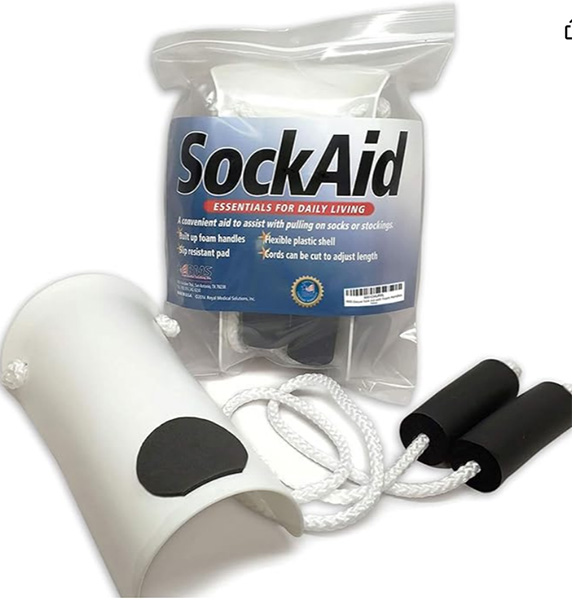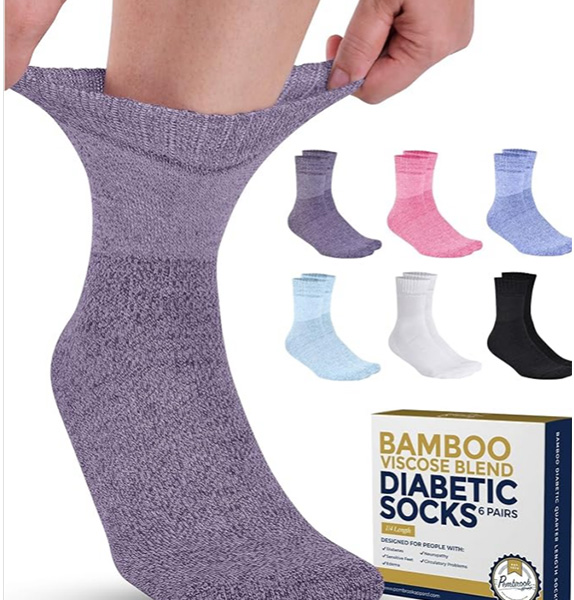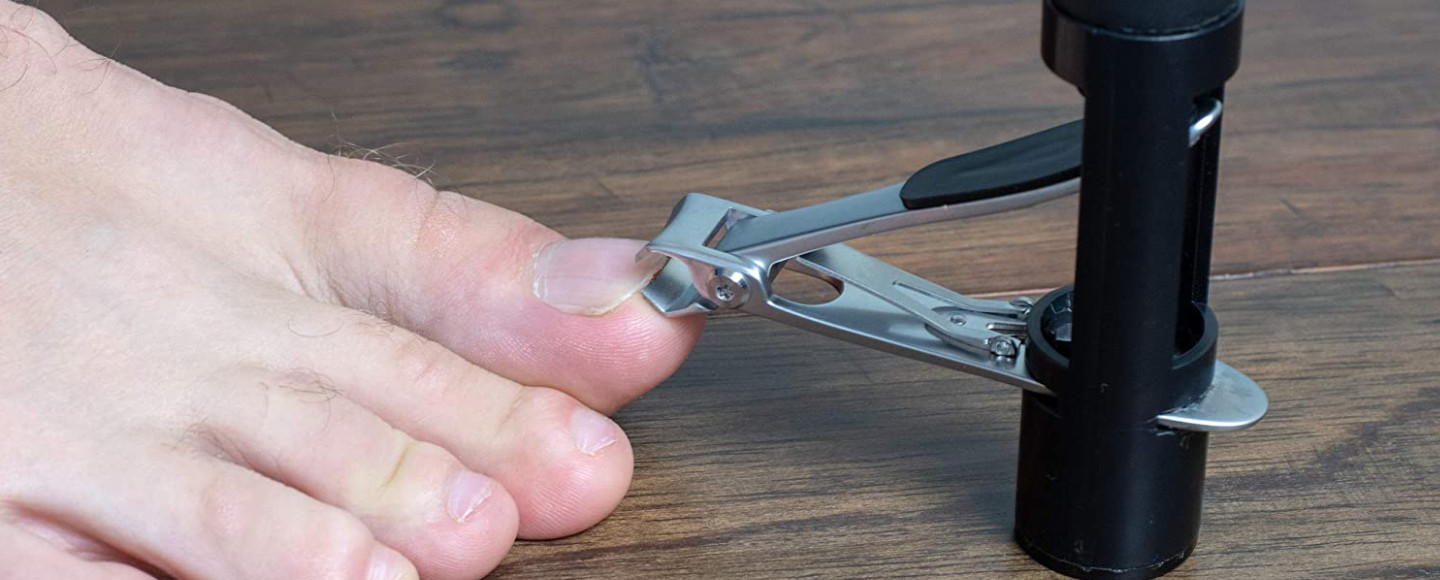For many older adults, something as simple as putting on a pair of socks can feel like a major challenge. Bending down, reaching the feet, or gripping tight fabric may cause pain, strain, or even lead to balance issues and falls. If you or a loved one lives with arthritis, joint stiffness, back pain, swelling …
For many older adults, something as simple as putting on a pair of socks can feel like a major challenge. Bending down, reaching the feet, or gripping tight fabric may cause pain, strain, or even lead to balance issues and falls.
If you or a loved one lives with arthritis, joint stiffness, back pain, swelling in the legs, or limited mobility, the morning routine of dressing can start with frustration—especially when socks won’t cooperate.
The good news? There are easier, safer ways to get socks on—without pain, strain, or giving up independence. In this guide, we’ll walk you through practical solutions that make sock time simple again.
Table of Contents
- Why Putting On Socks Can Be a Daily Struggle for Seniors
- Use a Sock Aid: The Easiest Way Without Bending
- Try Easy-On Socks: Designed for Seniors
- How to Put On Compression Socks for Elderly (Without the Struggle)
- Sitting vs. Standing: The Safest Way to Put On Socks
- Caregiver Tips: How to Help a Senior Put On Socks
- Alternative Tools and Tricks That Really Work
- Choosing the Right Socks Matters: Look for Senior-Friendly Features
- When to Talk to a Doctor
- Final Thoughts: Small Changes, Big Comfort
Why Putting On Socks Can Be a Daily Struggle for Seniors
As we age, our bodies change. Everyday tasks that once felt automatic can become difficult—or even painful.
Common conditions like:
- Osteoarthritis or rheumatoid arthritis in hands and knees
- Swollen feet and ankles (often due to heart, kidney, or circulation issues)
- Back or hip pain that limits bending
- Neuropathy or numbness that makes fine motor tasks harder
- Balance concerns that make standing on one foot risky
…can all turn sock-wearing into a daily battle.
And let’s not forget compression socks—while they offer great benefits for circulation and swelling, they’re often tight, stiff, and hard to pull on, especially for someone with weak grip or stiff fingers.
The result? Many seniors skip socks altogether—or worse, force them on in ways that cause pain or skin damage.
But there’s no need to suffer in silence or give up comfort. Let’s look at some easy ways to put on socks for elderly adults that protect dignity, reduce pain, and save time.
Use a Sock Aid: The Easiest Way to Put On Socks Without Bending
One of the most helpful tools for seniors is a sock aid—a simple device that lets you put on socks while sitting down, without bending or reaching.
What Is a Sock Aid?
A sock aid is a lightweight tool (usually made of plastic or wood with a fabric sling) that holds the sock open and guides it smoothly over the foot and heel. You place the sock on the aid, slide your foot in, and pull the drawstrings to roll the sock up—no bending required.
It’s one of the best sock aids for seniors, especially for those with:
- Arthritis in hands or knees
- Back pain
- Poor balance
- Swollen feet
And yes—it works great for compression socks for elderly too, when used correctly.
How to Use a Sock Aid (Step-by-Step)
- Sit in a sturdy chair with good back support.
- Place the sock over the sock aid’s frame, making sure the heel is aligned.
- Slide your foot into the sock through the opening.
- Hold the foot in place with one hand, then gently pull the two drawstrings to roll the sock up over the heel and calf.
- Remove the aid and adjust the sock as needed.
Tip: If you're helping a loved one, guide their foot into the sock and do the pulling for them. It’s a small act of care that makes a big difference.
There are many types of sock aids—from basic models to long-handled ones with built-in reachers. Look for ones with non-slip grips and wide openings for easier use.
For easy way to put on socks with sock aid, try the RNS Sock Aid Pro—a top-rated option known for its smooth glide and durability.
👉 Want more options? See our full review: Best Sock Aids and Assist Devices for the Elderly.
Try Easy-On Socks: Socks Designed for Seniors
Not all socks are created equal. Some are made specifically for seniors who want comfort, ease, and support—without the fight.
These easy-to-put-on socks for elderly adults often feature:
- Seamless toes to prevent irritation
- Wide, non-binding cuffs that don’t dig into legs
- Stretchy, adaptive fabric that fits swollen feet
- Grippy soles for safety (great for non-slip socks)
- Pull loops or tabs for easier handling
And many are designed as relief socks for seniors—meant to soothe discomfort, improve circulation, or reduce swelling.
What Are Relief Socks for Seniors?
Relief socks for seniors aren’t just soft—they’re functional. They may include features like:
- Light compression (15–20 mmHg) to help with mild swelling
- Moisture-wicking fabric to prevent irritation
- Arch support for foot fatigue
- Antimicrobial treatment to reduce odor
They’re a gentler alternative to medical-grade compression socks and perfect for daily wear.
For example:
- Women’s relief socks for seniors often come in pretty colors and floral patterns—because comfort shouldn’t mean boring.
- Men’s relief socks for seniors tend to be in classic navy, black, or gray, with a focus on durability and support.
- Orthopedic pain relief socks for seniors may include targeted padding or compression zones to ease plantar fasciitis or joint pain.
Pro Tip: Look for brands that offer easy-on designs—like magnetic closures, zipper sides, or rear-entry styles. These are true easy-to-put-on socks for seniors and can be a blessing for those with limited dexterity.
Popular brands include Dr. Segal’s Comfort Socks and Pembrook Adaptive Socks.
👉 Suggested article: Best Relief Socks for Seniors: Pain-Free Comfort All Day
How to Put On Compression Socks for Elderly (Without the Struggle)
Compression socks are often prescribed to help with swelling, poor circulation, or varicose veins. But let’s be honest—they can be tough to put on, especially for seniors with weak hands or swollen feet.
The good news? There is an easy way to put on compression stockings for elderly adults—without tearing the fabric or hurting your back.
Why Compression Socks Are Hard to Put On
Medical-grade compression socks (usually 20–30 mmHg) are designed to be tight. That’s how they work. But that tightness makes them:
- Difficult to stretch over the heel
- Hard to grip with arthritic fingers
- Risky to pull on if you have balance issues
And if you’re dealing with swollen feet, it can feel impossible.
Step-by-Step: Easy Way to Put On Compression Socks for Elderly
- Put them on first thing in the morning
Swelling is usually lowest in the morning. Put compression socks on before your feet have a chance to puff up. - Use rubber gloves or a plastic bag
Wearing rubber dish gloves or placing a plastic grocery bag over your hand gives you better grip on the slippery fabric. - Turn the sock inside out
Start by turning the top half of the sock inside out—about halfway down. This creates a “sleeve” that’s easier to slide over the foot. - Insert your foot
Place your foot into the sock (heel first), making sure it’s in the right spot. - Pull the outer cuff up gradually
Now, grab the outside cuff and slowly roll it up your leg, smoothing as you go. Don’t pull from the top—this can damage the fabric. - Use a sock aid (if available)
Yes, there are sock aids designed for compression socks! These help you get the sock on without straining your hands or back.
Bonus Tip: If your loved one has swollen feet, consider the best compression socks for elderly with swollen feet—these are often made with extra stretch and adaptive materials that conform to changing foot size.
👉 Suggested article: Best Compression Socks for Elderly with Swollen Feet
Sitting vs. Standing: The Safest Way to Put On Socks
Balance is everything.
For seniors with mobility issues, standing on one leg to put on a sock is not just hard—it’s dangerous. Falls are a leading cause of injury in older adults, and something as simple as dressing can trigger a trip or tumble.
That’s why the easy way to put on socks for elderly often starts with sitting down.
Why Sitting Is Safer (and Easier)
When you sit:
- Your balance is stable
- You can use your hands more effectively
- You can use tools like sock aids or reachers
- You reduce strain on your back and knees
So always encourage sitting—on a bed, chair, or wheelchair—when putting on socks.
And if you’re helping someone, make sure they’re seated securely before you begin.
Caregiver Tips: How to Help a Senior Put On Socks (Without Hurting Them)
If you’re a family caregiver, you may help your loved one dress each day. Here’s how to make sock time easier—for both of you.
Be Gentle, But Firm
- Support their foot with one hand while guiding the sock on with the other.
- Avoid pulling too hard, especially if they have fragile skin or swelling.
- Warm the socks slightly (in your hands or near a heater) if they feel stiff—this makes them more pliable.
Use Adaptive Tools
- A long-handled sock aid lets you help without bending.
- A reacher/grabber tool can help position the sock or adjust the cuff.
- Rubber gloves improve grip on slippery fabrics.
Respect Dignity
Dressing can feel vulnerable. Always:
- Ask before helping (“Would you like me to help with your socks?”)
- Explain what you’re doing
- Let them do as much as they can on their own
Small gestures go a long way in preserving independence and respect.
Alternative Tools and Tricks That Really Work
Beyond sock aids, there are other clever hacks seniors and caregivers use every day.
The Plastic Bag Trick
Put a clean plastic grocery bag over your foot before sliding on a tight sock. The smooth surface reduces friction, making it easier to get the sock on. Remove the bag once the sock is in place.
Works great for compression stockings and tight-knit socks.
The Towel Loop Method
Roll a small towel into a loop and place it under the heel of the sock. Hold the ends of the towel and use it to pull the sock up your leg—less strain on hands and back.
Use a Drying Rack or Frame
Some seniors use a sock-putting-on frame—a U-shaped device that holds the sock open. Just slide your foot in and pull the sock up. Great for those with limited hand strength.
Try Magnetic or Zipper Socks
These innovative socks have magnetic closures along the side or hidden zippers in the back, so you don’t have to stretch the fabric over your foot.
Perfect for seniors with arthritis or hand pain.
Choosing the Right Socks Matters: Look for Senior-Friendly Features
Not all socks are made for aging feet. When shopping for easy-to-put-on socks for elderly, look for:
| Feature | Why It Helps |
|---|---|
| Seamless design | Prevents rubbing and blisters |
| Non-binding tops | Won’t cut off circulation or dig into legs |
| Extra stretch | Fits swollen feet and large calves |
| Pull tabs or loops | Easier to grip and adjust |
| Moisture-wicking fabric | Keeps feet dry and comfortable |
| Grippy soles | Reduces slip risk indoors |
And if you’re looking for pain relief socks for seniors, consider options with:
- Light compression
- Arch support
- Cushioned soles
- Temperature regulation
These small details make a big difference in daily comfort.
When to Talk to a Doctor
If putting on socks has become painful or impossible, it may be time to talk to a healthcare provider.
Persistent swelling, skin changes, numbness, or pain could be signs of:
- Circulatory issues
- Heart or kidney problems
- Nerve damage
And if compression socks are prescribed but too hard to use, ask about:
- Lower compression levels
- Alternatives to compression socks for elderly
- Adaptive devices covered by insurance
You don’t have to tough it out. Help is available.
👉 Suggested article: Alternatives to Compression Socks for Seniors: What Works?
Final Thoughts: Small Changes, Big Comfort
Putting on socks shouldn’t be a daily battle. With the right tools, techniques, and socks, it can be simple, safe, and even dignified.
Whether you’re an older adult managing arthritis, a caregiver helping a parent, or just looking for more comfort, remember:
- An easy way to put on socks for elderly exists—use a sock aid, adaptive socks, or simple tricks.
- Compression socks don’t have to be a struggle—try the inside-out method or a specialized aid.
- Relief socks for seniors offer comfort and support without the tightness.
- Sitting down and using tools keeps you safe and reduces strain.
And most importantly: You’re not alone. Millions of seniors face this challenge—and millions have found easier ways.
Let this be the day you stop fighting with socks and start finding solutions that work.
Looking for more helpful tips?
👉 Subscribe to our free Senior Comfort Tips newsletter—practical advice delivered straight to your inbox.








